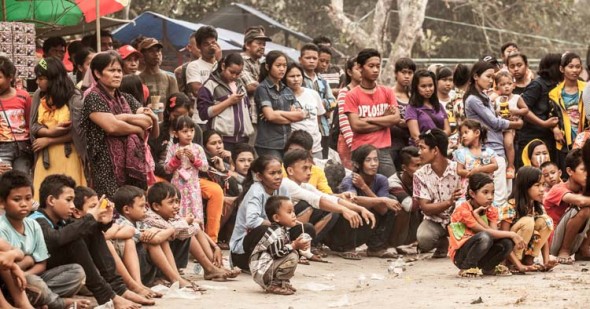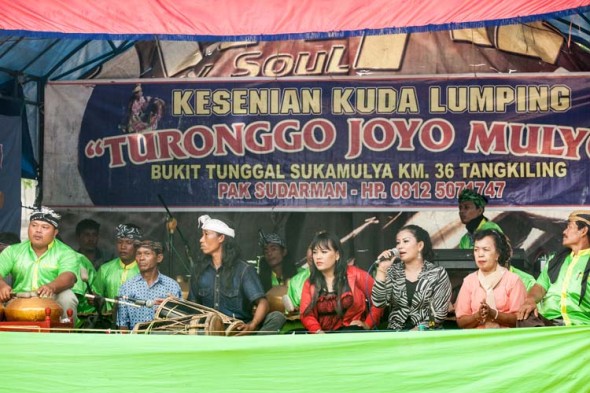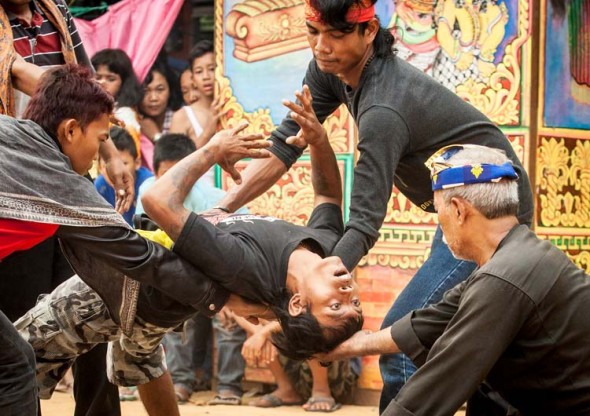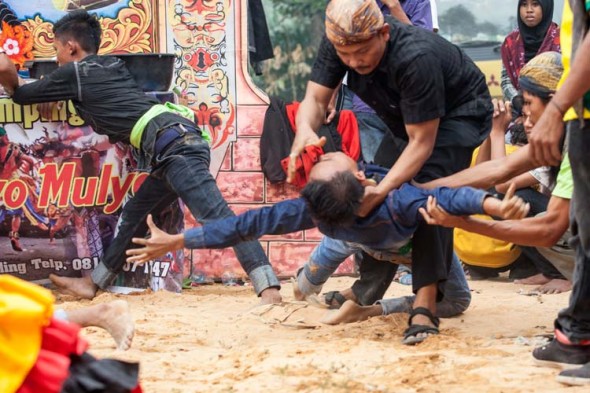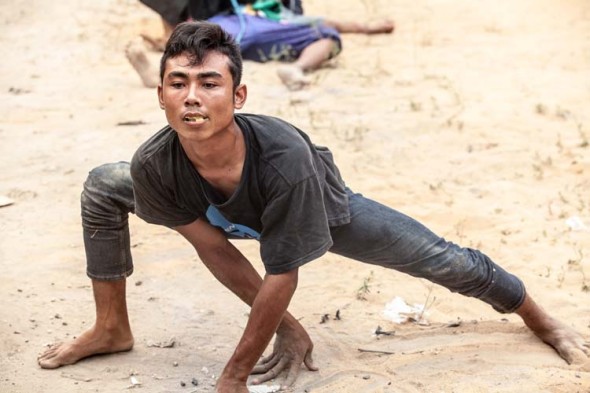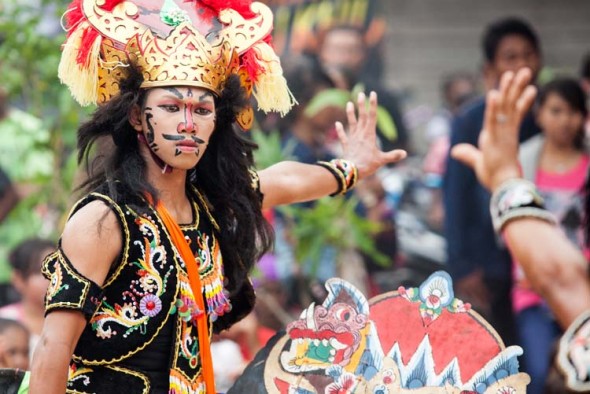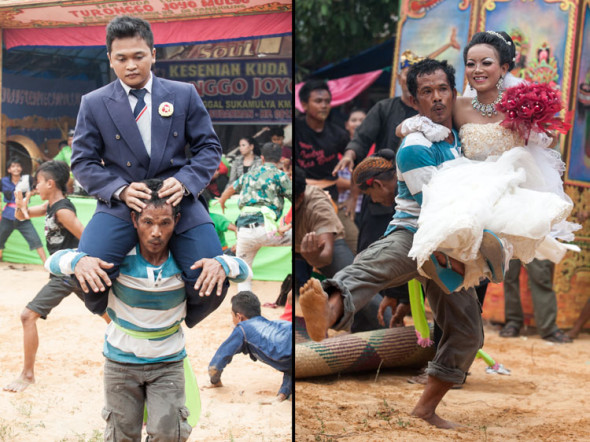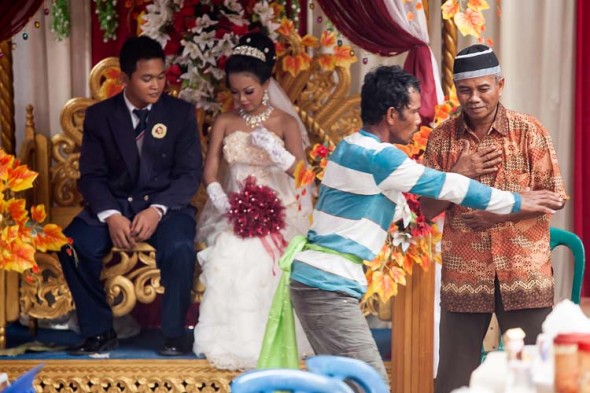One of the nice by-products of the after-school art classes at the YUM library, which are now co-hosted by Karen, is that she makes connections with families around the immediate area. So, at the Sunday produce market at Tangkiling this week, a little girl tugged at her sleeve and shyly said “Selamat Pagi, Ibu Karen” and then introduced us to her dad.
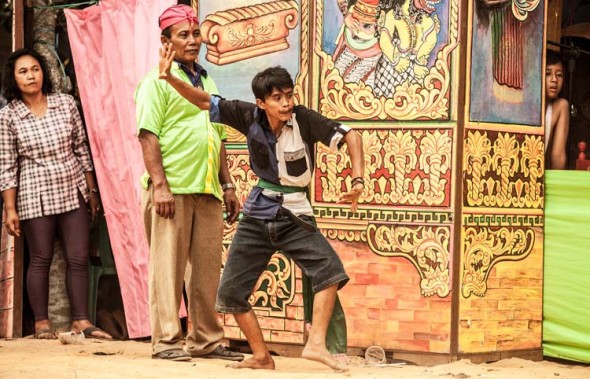
Another time, two girls from the (Javanese transmigrant) village of Suka Mulya invited her to come to the village “to see some dancing”. Not knowing what to expect, she turned up there at the appointed time (Tuesday at 2pm), to find that a large wedding celebration was in progress. A temporary stage had been set up in a grove between the houses, and a small gamelan orchestra had been installed. And the dance performance … well, it was a Kuda Lumping performance, and she phoned me at work to say: “get over here right away, it’s amazing!”
The Kuda Lumping originated in central and east Java, and is a very special thing indeed. Over a couple of hours, a number of young men and teenage boys go into a state of trance, and supposedly become possessed by the spirits of horses. They strut around, stamping the ground, rolling in the dirt, eating grass and chaff (and sometimes, we were told, they eat glass and walk over burning coals), seemingly oblivious to pain or the crowd around. The meaning and origin of the Kuda Lumping is unclear. It goes back at least several hundred years, with one theory being that it began with Mataram Empire cavalry battling against the Dutch – but it could be much older again…
The gamelan plays fast, just a few gongs and several prominent drums, and with vocalists alternately singing, wailing and making syncopated screeching sounds. A woodwind instrument (I don’t know the name) plays over the top, sounding like a jazz improvisation on an oboe. It’s quite powerful and other-worldly, and actually sounds rather better and more melodic than you might imagine!
Overseeing the ‘trancers’ are a small number of very serious-faced older men (perhaps shamans) who ensure that the boys don’t hurt themselves as they trot and canter around. It’s a bit wild and chaotic at times, looking like it might spiral out of control, but the older guys keep a lid on it, and ensure that there aren’t too many in trance at any one time. These ‘minders’ have some kind of power over the horse-boys, and go through a dramatic and elaborate procedure to bring each of the boys out of trance.
This can involve tapping them on the forehead to make them pass out backwards into the arms of waiting support crew, wiping a cloth violently across the boy’s forehead, or … striking him three times around the abdomen with a whip. And they don’t appear to hold back with the whip arm, either! Once returned to normal consciousness from the trance, the boys look dazed and confused, with a what-am-I-doing-here expression on their faces, and they are ushered off backstage to ‘recover’.
We had seen a Kuda Lumping performance once before, in 2009 near the Prambanan temple outside of Jogjakarta. On both occasions we were the only non-Indonesians present, and the structure of it was much the same. On both occasions the trances looked half-real, half-contrived. We did see that some of the trancers were sitting backstage in a very spaced-out state for some time after they came offstage. Perhaps they were just exhausted from all that horsing around.
One difference on this occasion was that the bride and groom got involved at one point, with one of the trancers carrying first the groom, then the bride, through the crowd and into the wedding pavilion and onto a little throne set up for them there. They each tried to look dignified as their ‘horse’ swerved and reared up on the way.
We went over to congratulate the bride and groom, and to pay our respects to their parents, and of course (this being Indonesia, perhaps the most hospitable place on the planet) we ended up sharing in the wedding feast and refreshments (i.e. buffet meal, cakes and coconut water).

